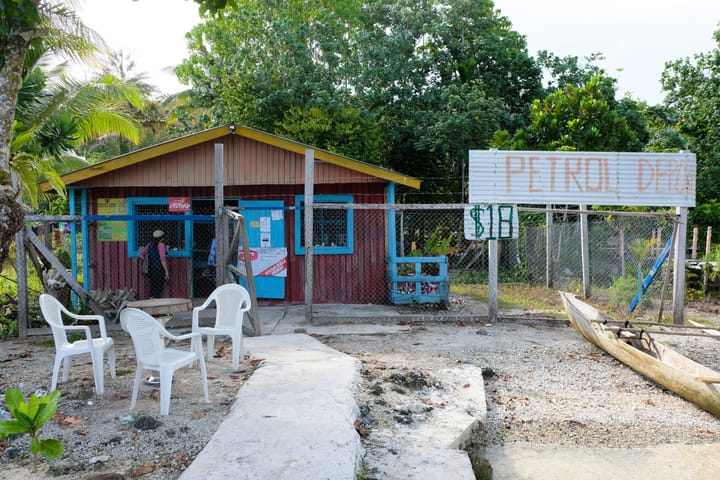Beyond sustainability in private sector development
Simon White | Private sector development can contribute to transformational adaptation and the regeneration of our ecologies and ecosystems.

It is increasingly apparent that more than simply "sustainability" is needed to address the economic and social transformations our planet requires. While the deadline for achieving the UN Sustainable Development Goals is only a few years away, we face a profound challenge with far-reaching implications for private sector development and transformational climate adaptation.
Support for economic and private sector development has been framed by concepts, such as constant growth and expansion and the extraction of natural resources, that need to be questioned further. In the past, these have often been treated as fringe issues within the prevailing neoclassical economic theory.
While market-based solutions offer the most tangible and immediately feasible mechanisms within market economies, more than these are needed. Pricing signals are essential, but our challenges require more than what markets alone can provide. Good regulation, innovation, and other government-led interventions are required to shift markets and change the behaviours of private investors and business owners of all sizes. We need to think more deeply about the world we want to live in. This includes considerations of place-based economic development and the ecologies in which we live and work.
Going beyond sustainability to regenerative private sector development
Broadly defined, sustainability aims to meet current needs without compromising future generations. Typically referring to achieving economic, social and environmental goals, sustainable development incorporates the dominant system of development based on extraction and a linear growth pattern.
However, this approach is left wanting. A linear economy weakens the planet's regenerative capacity, making sustainability harder to achieve. Sustainability is necessary but insufficient for long-term welfare. Instead, we must go beyond sustaining and begin to regenerate our ability to meet present and future demands.
Most counties have adopted an emissions target of net zero. This refers to minimising carbon emissions to a negligible level that can be effectively absorbed and stored by nature or other carbon dioxide removal strategies, resulting in no excess in the atmosphere. Scientific evidence indicates that to prevent the worst effects of climate change and ensure a viable planet, the rise in global temperatures must be restricted to 1.5°C above pre-industrial levels. As stipulated in the Paris Agreement, emissions must be cut by 45% by 2030 and achieve net zero by 2050.
The problem is that achieving net zero is no longer enough. The concept of sustainability overlooks the natural resources we have already depleted and polluted since the Industrial Revolution. While reducing the carbon we add to the environment is a priority, we also need to consider the existing carbon and how this can be reduced. We need to regenerate.
These issues are also encapsulated in Nature Positive – a global societal goal defined as "Halt and Reverse Nature Loss by 2030 on a 2020 baseline, and achieve full recovery by 2050." This means ensuring more nature in the world in 2030 than 2020 and continued recovery after that.
John Fullerton coined the term regenerative capitalism in 2015 to describe business practices that restore and build rather than exploit and destroy. Regeneration is about viewing the goal of net-zero carbon emissions as a stop-off on the longer journey to create the conditions for life to flourish resiliently and renew infinitely.
Shifting the business paradigm
The World Business Council for Sustainable Development argues the need to "shift the underlying paradigm of business to adopt a just and regenerative mindset, embedding this into a new way of making decisions."
This means going beyond how a business minimises its environmental impact or prevents human rights abuses. It means recognising our interdependence with other people, other living beings and ecosystems, and ultimately, how we enable all living beings to survive and thrive together." Adopting a just and regenerative approach means embracing the power of nature to renew and regenerate, understanding that humans are a fundamental part of nature, and respecting everyone's universal rights and potential to thrive."
A business with a just and regenerative mindset pursues a future in which:
- Social and environmental systems are thriving.
- Planetary health has been rapidly stabilised.
- Human rights are universally respected.
- Fairer ways to create and distribute value have been adopted.
- Resilience and vitality across generations and geographies are supported.
I've written about the steps to create a climate-resilient entrepreneurial ecosystem.
Economic and market redesign
A regenerative approach requires redesigning our economic system and the role of markets. This includes what some have described as "biomimicry" or attempts to emulate nature.
I have written on the circular economy—a system designed to minimise waste and resource use by recycling and reusing materials, thus reducing inputs and greenhouse gas emissions. Companies like Neste have moved into the circular economy space by enabling the production of and by reusing waste as a valuable raw material in its production processes.
A regenerative approach applies nature-based solutions. These are actions “inspired by, supported by, or copied from nature; both using and enhancing existing solutions to challenges, as well as exploring more novel solutions” to “help societies address a variety of environmental, social and economic challenges in sustainable ways” (European Commission). Nature-based solutions can generate ecosystem services and other benefits from nature that can be combined with conventional planning and development structures, turning environmental, social, and economic challenges into innovation opportunities.
The EU found that private sector investment in nature-based solutions will only increase significantly with government intervention to provide a profit motive for private sector participation. This requires a carrot-and-stick approach. The carrot offers private entities a financial incentive to invest in nature-based solutions (i.e., a “carrot” or reward), while the stick imposes financial burdens on private entities that do not invest in nature-based solutions or are responsible for the negative effects requiring nature-based solutions to resolve them.
Nature positive business environment reforms
The United Nations argues that governments must support nature-based solutions through supply and demand side interventions. This includes support for business development and innovation and reform of the business environment. Key reforms include, ensuring transparency, accountability and effective resource allocation by implementing and supporting benchmarks, standards and markers for both public and private nature-based-solutions investments.
Business environment reforms encourage a regulatory enabling environment that aligns economic activities and sustainability agendas by integrating nature-based solutions criteria in green taxonomies. Governments can also support a credible market for biodiversity credits by enhancing uptake and reducing transaction costs. Biodiversity credits are certificates representing a measured and evidence-based unit of positive biodiversity outcome that is durable and additional to what would have otherwise occurred in the market. This market-based mechanism incentivises and funds projects in biodiversity and additional.
The World Wildlife Fund says that a conducive framework is needed to create rapid and substantial shifts in capital flows. Key to this is sustainable finance taxonomies that provide a framework defining what counts as green or environmentally harmful finance, classifying investments based on environmental performance criteria. By aligning private financing strategies with nature-positive outcomes, policymakers can promote investments in the conservation and preservation of nature. This can be done by including supply chain criteria in the taxonomies of countries that import commodities that negatively impact nature. Additionally, policymakers from "megadiverse countries" should consider introducing taxonomies that their important trade partners can formally recognise.
Regenerative innovation
Innovation lies at the heart of an economic transition that involves the private sector. It is about changing the products and services we purchase and the business models that produce them.
From a regenerative perspective, Vanita and Neetu Yadav define regenerative innovation as a "novel product, service or process that goes beyond commercial value and seeks to address planetary health and societal wellbeing." In this conception, the value from innovation accrues first to “nature as the major stakeholder”, then to other stakeholders (such as government, society, customers, suppliers, investors and employees), and then finally to the organisation. This is a more progressive approach than sustainability and circularity in terms of its value, stakeholder priority and holistic vision.
They describe four archetypes of regenerative innovation:
- Urban transformation innovation. Restoring, renewing and enhancing urban environments through the principles of regeneration. This focuses on the regeneration of cities and urban environments using a socio-ecological systems approach to innovation. Examples of regenerative innovation are emerging in city projects as part of the EU’s 100 Climate Neutral and Smart Cities by 2030.
- Technological innovation seeks to regenerate nature and social well-being through technology. Technology can be used to reduce waste, offer new natural resource substitutes, and enhance societal well-being. Examples include regenerative supply chains using Industry 5.0 technology and AI and Internet-of-Things innovations for smart active transportation and societal well-being.
- Responsible innovation. Regeneration occurs through the convergence of technology, society, communities, and nature. An example is Blue Penguins Pukekura, a regenerative tourism enterprise owned by a Māori community in Dunedin, which balances ecotourism with indigenous values by promoting collaboration, capacity building, and economic resilience.
- Business model innovation. Based on the interdependence of government, business, human society and nature to achieve a positive overall impact that gives more to nature and society than it takes. For example, UK firm Notpla employs a regenerative business model that uses seaweed to create biodegradable packaging and products.
The limits of business-as-usual
We can't continue to do things in the way we have. There are environmental, social and economic imperatives that cannot be ignored. This requires governments, businesses and the development community to focus on the transition.
This year's report to COP 29 indicates that of the countries that provided an adaptation component to the national determine contributions, 41 per cent referred to the importance of transformational adaptation to "promote technological innovation and policy or legal reform, build institutional capacity for transformational adaptation, create new financing mechanisms and influence the behavioural change needed for transformational adaptation." This included promoting gender-inclusive approaches to transformational adaptation and the need for a deeper understanding of fairness and just transition in transformational adaptation.


